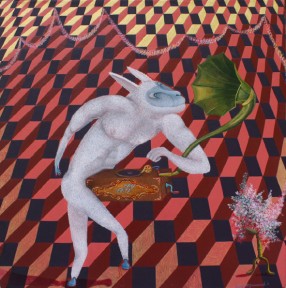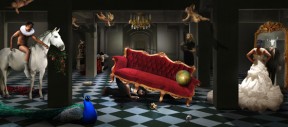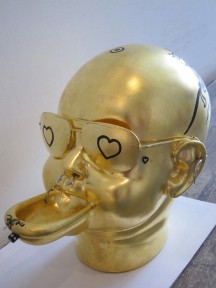Love is blind, they say. Or is it? Your first love is your last love, most believe. But does love last forever? Love should be celebrated at all times, and everywhere, we’ve been told. What happens when this emotion begins to destroy, sometimes cruelly? Love is perhaps the one word that has been so oversimplified – despite being inextricably linked with nuances of desire, jealousy, lust and even obsession – that it remains undefined for even the most articulate. At times, love induces a sense of sweeping contentment, at others it can become an itchy, nail-biting torment.
It is this complexity, or the darker side of love if one may call it thus, that five artists – Manjunath Kamath, Bose Krishnamachari, Chittrovanu Mazumdar, Chintan Upadhyay and Sana Arjumand – have brought forth in their work in a show titled Love Is A Four Letter Word at Latitude 28 in New Delhi. This love is not the love of fairy tales. Nor is this the love of tender compassion. This love is like a drug moving on a roller coaster of dizzying highs and woozy lows. It is the stuff that chases butterflies in the stomach, a distance memory that haunts an addict.
Feelings are best expressed through words, and when it comes to love, you must say it with all your emotions. But when an artist makes the statement, it reveals what lies beneath the seemingly innocuous word. Sana Arjumand has, for example, titled one of her canvases, Politics of Love, to draw attention to what love means in the age of global media. Looking longingly into a gramophone, a goat-like being is enraptured with nostalgia. By painting the opposite of the illusion of ideal scenarios, she questions the terms and conditions that have been carved on the package of love and underlines the cultural clichés that overshadow what we understand to be real and worthy.
She says about her work: “‘Love is blind’ was the first proverb that I heard as a young girl. When I asked my mother to explain, she said that love makes one so blind, that they become capable of falling in love with a donkey. I wonder if these old quotes about love are valid any more in today’s world, especially in this age of television when our emotions are rendered by globalization. Most of our moves seem planned and weighed. I don’t think love is blind, at least not any more. I think love is measured and reconsidered and hence predictable.”
Bose Krishnamachari’s three-dimensional work titled Love No Bose, a big black work in duco paint on wood interspersed with small spherical projections completely undermine the notion of ‘love at first sight’. By incorporating the medium of Braille, the question he seems to be asking is – if vision plays a determining factor in creating attraction, what does one do without it? By creating a site for temporary blindness using Braille paper, he wants the viewer to understand that denial of a faculty is necessary to know, feel, exercise and also enhance the feeling of love. “One needs to have a ‘vision’ and not merely ‘sight’ to grasp the real meaning of love,” he says.
Chintan Upadhyay’s fibre glass and gold leaf sculpture – untitled though it is – of a baby’s head covered with body piercing epitomises a contemporary caricature of a love struck youth. A pair of stylish sunglasses, more a reference to a mechanism of blindness than a rose-tinted view of love, accompanied with graffiti on the head is typical of Upadhyay’s tongue-in-cheek treatment of art.
The figure of the gold baby resurfaces in Upadhyay’s oil and acrylics on canvas, where brightly coloured bouquets of flowers are the central subjects. But what jolts one out of submission to this beauty is the golden baby which turns its head towards the viewer as it crawls away, while the bouquet of bleeding flowers seems to emerge from its body. In another canvas, the bouquet grows out of a pool of blood, while sinister looking infants emerge from the flowers, signifiers of a violent fertility. In a third work titled Burning House, a series of eight small works, a smouldering house slowly turns into ash indicating a love that cannot be domesticated. Love, and what grows out of it, certainly is not all beautiful, the artist seems to say.
For Manjunath Kamath, love changes every moment, rather than existing as an absolute truth. “I am emphasizing on an abstract language of love which is opposed to the commercialization infused gesture in modern times which is quite fake,” he says. He takes a dig at this standardized ideal of love in digital print titled Fake Love Story replete with symbols and objects which are usually associated with love and passion. But Kamath is known for making a mockery of the mundane, and hence in his work, a bride in white stands before a gilded mirror to see her groom – alluding to the idea that the lover is partially a reflection of one’s own desires – but is faced with the horrifying prospect of a husband who is both man and animal.
In Chittrovanu Mazumdar’s paintings, violence and sensuality are chromatically intertwined. Painted in various shades of red, a colour depictive of blood, love, possession and death, the subjects of his canvas are dark and symbolic of the inherent yet hidden violence in human desire. In his sculptural work, a dark, metallic vehicle that carries a rose-covered monolith, the conflicting materials in hard metal and soft petalled roses come together to suggest the internal incongruities of romance.
What the artists have done here is to expose the excesses hidden inside the romanticised notion of love. They might as well have called the show ‘Love is more than a four letter word’!
Love Is A Four Letter Word is on at Gallery Latitude 28, F-208, Lado Sarai,
New Delhi till September 30, 2011, 11 a.m. to 7 p.m.
Pic 1: Politics of Love by Sana Arjumand
Pic 2: Fake Love Story by Manjunath Kamath
Pic 3: Untitled sculpture by Chintan Upadhyay
Poonam Goel is a freelance journalist and has covered the arts for over 15 years. She contributes on visual arts for various newspapers, magazines and online media. More about her on Story Wallahs. Write to her @ poonamgoel2410@gmail.com








